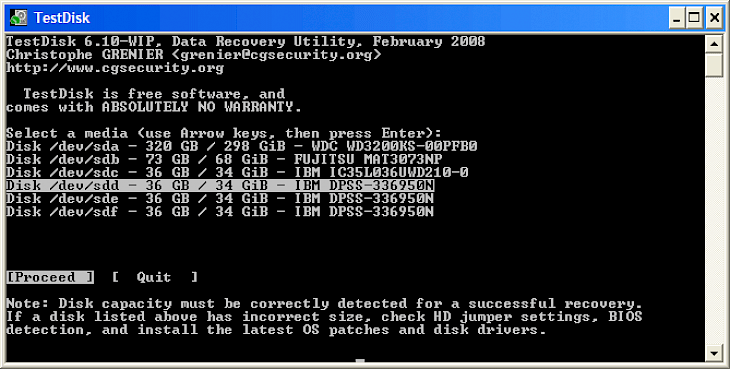

- #Testdisk windows 8 install#
- #Testdisk windows 8 full#
- #Testdisk windows 8 windows 8#
- #Testdisk windows 8 professional#
- #Testdisk windows 8 series#
Now before attempting to recover the files that we deleted, we put a bunch of audio files onto the E: drive What Happens When You Overwrite Some of the Deleted Data ? Now you see all of the deleted files on the E: drive that you can recoverĪfter telling it where to copy the undeleted data to, we can open it and it all works. Select our E: drive partition and select UNDELETE Then we Shift-Delete everything on the E: drive
#Testdisk windows 8 full#
We then put a folder full of important files and some pictures on the E: drive. Since TestDisk looks at a whole partition for deleted files we will create a little 1GB test partition on our disk drive and call it the E: drive. Use TestDisk to recover everything deleted on a partition and use PhotoRec to recover specific filetypes from a partition (all the. For this example we will be running it from within a Windows environment but it looks exactly the same as when you run it from a Linux Live environment like Puppy Linux. However, when you are trying to recover files from a broken Windows machine using a Linux bootdisk TestDisk and PhotoRec are your best choice. It also has better directory structure recovery than TestDisk and is very easy to use. Recuva is great for recovering files when you are working in a Windows environment ( See Part 1 of this series). When to use TestDisk or PhotoRec for Deleted File Recovery It also comes with the program PhotoRec which has some advantages for recovering specific file types like pictures or Outlook mailboxes (currently over 200 file types).
#Testdisk windows 8 series#
TestDisk is a program that does lots of things that we will talk about later in this series but for this post we are looking at its file undelete capabilities.
#Testdisk windows 8 professional#
We’ll do this in Windows XP Professional Service Pack 3 Simple Recovery with Testdisk and PhotoRec Recovery is often done by looking at the raw data on the disk for unreferenced data, then determine the file type and directory structure, rebuild them and save them elsewhere. If the file wasn’t fragmented and the clusters haven’t been reused, you should have a great chance of getting it back. When a file is deleted, the list of disk clusters occupied by the file is erased, marking those sectors available for use by other files created or modified thereafter.

We will be looking at Windows (FAT and NTFS) filesystems.ĭeleted files are not removed from the hard drive until the space that they occupy is needed by a new file. In this series we’ll look at some real world examples of disastrous situations salvaged and made better again. SSD’s provide some new challenges due to techniques they use to extend their life expectancy but for the most part are recoverable in the same manner as platter based drives. Also, the fact that CD’s, DVD’s, flash drives, SD cards and USB keys are made to behave like hard drives makes them candidates for recovery using the same tools. However, the effectiveness and ease of use of free tools has increased greatly. I take no responsibility for anything you do based on my examples or the information that I provide here.ĭata recovery from hard drives has not changed much in decades. If you try them yourself, it might cause damage or irreparable loss. In this question I wrongly assumed that my hard disk was partitioned using MBR instead of GPT.Part 2 Recover Deleted files with Testdisk and PhotoRecĭISCLAIMER: These examples use techniques that I actually employ in the real world to deal with real problems. Data was not overwritten (install didn't proceed), but the partition table was lost.
#Testdisk windows 8 install#
I guess my problem comes from my ignorance of what are primary partitions, as opposed to logical or extended partitions.įor the record, the partition table was lost at the beginning of a Ubuntu install in which I asked to replace the current Linux partition with an LVM partition.

I suppose it's because a maximum of only 4 primary partition tables is tolerated? I am supposed to flag the partitions which I would like to recover with one of those letters I tried flagging all partitions as primary, but Testdisk indicates it's a "bad structure". I have no idea which are the primary bootable (*), primary (P), logical (L), extended (E) or deleted (D) partitions. Here is what Testdisk shows after a quick scan of the Intel/PC partitions: The Linux install contains four partitions: a swap partition, the / ext4 partition, the /home ext4 partition and a tiny unallocated partition.
#Testdisk windows 8 windows 8#
The disk contains a dual boot Windows 8 along a Linux OS. I'm trying to recover a partition table with testdisk.


 0 kommentar(er)
0 kommentar(er)
